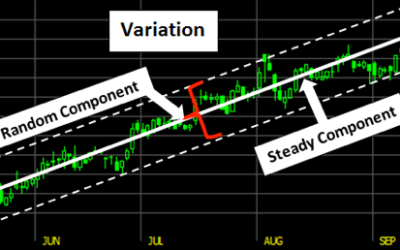Stock Market Variation – Stat think, gives you an edge and is taught in our book: Provident investing.
Learn with our products
Statistical thinking: Statistics, Variation and volatility is considered here:
This philosophy (Stat-think) relates to how people take in and process information (learning) as well as how they respond to it (action). It is based on the following:
1. Variation exists in all processes. That is always true, a fact of life!
2. All variation is the result of two separate causal systems:
Dr. Walter A. Shewhart, of Bell Telephone Laboratories, developed a theory in the 1920’s where he identified two components of variation; a steady component and an intermittent component. The first, called common or random variation, is caused by chance or undiscovered causes. Intermittent variation results from assignable causes (causes that can be discovered).
3. A look at any stock price chart will show both systems of causes (Fig. 1);
Fig. 1 Variation Components
4. A trend is the result of an assignable cause, for instance, a company demonstrating improving business fundamentals.
5. The day to day variations in stock prices have a lot of noise (random variation) along with any assignable variation.
6. Understanding this principle of variation is an important key to our investment success.
7. Stock Market Variation – Stat think, separates statistical thinking from methods. (“Methods” use statistics to measure or to model behavior, kindly referred to as number crunching. We’re more interested in the “Thinking” aspect)
8. By proper use of “Stat-think,” we are more apt to understand and to take advantage of the variation we deal with in all things, specifically in the market.
So, how do we use Stock Market Variation – Stat think, in our investing?
9. A person with his Stat-Think cap on looks at the volatility in market prices and sees a wealth of opportunity.
Peter Lynch: “I have traditionally liked a certain formation. It’s what I call the EKG of a rock. It’s never changing. Now you know if something goes right with this company, the stock is going north. In reality, its probably just going to go sideways forever. So if you’re right it goes north and if your wrong it goes sideways.”
Stock Market Guru’s, Peter Tanous, New York Financial Institute, 1997. Quotations from INVESTMENT GURUS by Peter Tanous. Copyright (c) 1996. Reprinted with permission of Prentice Hall Press, a Division of Prentice Hall Direct. Available in bookstores
Peter Lynch sets up both causal systems in this paragraph. When he speaks of a ‘never-changing’ stock chart he is referring to one with no “assignable” trend. As that chart goes sideways, however, there will always be a system of random variation. Therein lies the opportunity.
It is this principle of variation that provides such an unlimited opportunity to take advantage of market variation. Stephen R. Covey (The 7 Habits of Highly Effective People, and Principle-Centered Leadership, Simon and Schuster) has trained us well in the use of principles, that is, natural systems that work under all conditions. Stat-think is such a principle.
Consider two popular market theories:
Efficient market theory: Stocks are always correctly priced since everything that is publicly known about the stock is reflected in its market price.
Random walk theory: The thesis that the majority of market behavior is random. Therefore, attempts to predict prices are useless and unprofitable.
If the market is efficient, nothing is required for success except rich and thorough business analysis of existing securities.
If stock prices are merely a random throw of the dice, in all the meaning of the term “random,” stock picks can be made with darts and the financial page (this has been done successfully during strong bull markets).
The truth lies somewhere in the middle. Opportunity exists because:
-
Warren Buffet tell us the most common cause of low prices is pessimism. He likes to do business in such an environment because of the prices it produces. He says that optimism is the enemy of the rational buyer.
-
The market will continue to overvalue and undervalue common stocks because of the human emotion that drives it. This pattern can be exploited to our great advantage with modern computerized tools that can sort through thousands of stocks and zero in on the ones that are the most undervalued.
-
Trading techniques exist to exploit these opportunities, e.g. Swing, Trend, Momentum, et al.
The investor who keeps his Stat-Think hat on will make investment decisions based on an understanding of market variations (volatility) and find comfort in the result.
Use Stock Market Variation – Stat think, in our investing!

